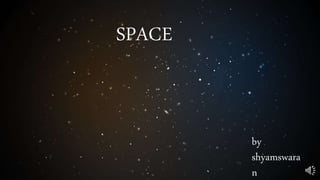
Space
- 2. space Space is the boundless three-dimensional extent in which object and events have relative position and direction. Physical space is often conceived in three linear dimensions, although modern physicists usually consider it, with time, to be part of a boundless four- dimensional continuum known as spacetime. The concept of space is considered to be of fundamental importance to an understanding of the physical universe. However, disagreement continues between philosophers over whether it is itself an entity, a relationship between entities,
- 3. Space travel Space exploration is the ongoing discovery and exploration of celestial structures in outer space by means of continuously evolving and growing space technology. While the study of space is carried out mainly by astronomers with telescopes, the physical exploration of space is conducted both by unmanned robotic space probes and human spaceflight. While the observation of objects in space, known as astronomy, predates reliable recorded history, it was the development of large and relatively efficient rockets during the mid- twentieth century that allowed physical space exploration to become a reality. Common rationales for exploring space include advancing scientific research, national prestige, uniting different nations, ensuring the future survival of humanity, and developing military and strategic advantages against other countries.
- 5. •A "falling star" or a "shooting star" has nothing at all to do with a star! These amazing streaks of light you can sometimes see in the night sky are caused by tiny bits of dust and rock called meteoroids falling into the Earth's atmosphere and burning up. FALLING STAR
- 6. SUN • The Sun is the star at the center of the Solar System. It is a nearly perfect sphere of hot plasma,[13][14] with internal convective motion that generates a magnetic field via a dynamo process.[15] It is by far the most important source of energy for life on Earth. Its diameter is about 109 times that of Earth, and its mass is about 330,000 times that of Earth, accounting for about 99.86% of the total mass of the Solar System.[16] About three quarters of the Sun's mass consists of hydrogen (~73%); the rest is mostly helium (~25%), with much smaller quantities of heavier elements, including oxygen, carbon, neon, and iron
- 7. Distance to Earth: 149.6 million km • Escape velocity (from the surface): 617.7 km/s; 55 × Earth • Equatorial surface gravity: 274.0 m/s2; 27.94 g; 27,542.29 cgs; 28 × Earth • Mean radiance (I<sub>sol</sub>): 2.009×107W·m−2·sr−1 • Age: ≈ 4.6 billion years • Luminosity (L<sub>sol</sub>): 3.828×1026 W; ≈ 3.75×1028 lm; ≈ 98 lm/W efficacy sun
- 8. MOON • The Moon is an astronomical body that orbits planet Earth, being Earth's only permanent natural satellite. It is the fifth-largest natural satellite in the Solar System, and the largest among planetary satellites relative to the size of the planet that it orbits (its primary). Following Jupiter's satellite Io, the Moon is second-densest satellite among those whose densities are known. • The average distance of the Moon from the Earth is 384,400 km (238,900 mi),[10][11] or 1.28 light- seconds. • The Moon is thought to have formed about 4.51 billion years ago, not long after Earth. There are several hypotheses for its origin; the most widely accepted explanation is that the Moon formed from the debris left over after a giant impact between Earth and a Mars-sized body called Theia
- 9. GALAXY • A galaxy is a gravitationally bound system of stars, stellar remnants, interstellar gas, dust, and dark matter.[1][2]The word galaxy is derived from the Greek galaxias (γαλαξίας), literally "milky", a reference to the Milky Way. Galaxies range in size from dwarfs with just a few billion (109) stars to giants with one hundred trillion (1014) stars,[3] each orbiting its galaxy's center of mass. Galaxies are categorized according to their visual morphology as elliptical,[4] spiral and irregular.[5] Many galaxies are thought to have black holes at their active centers. The Milky Way's central black hole, known as Sagittarius A*, has a mass four million times greater than the Sun.[6]As of March 2016, GN-z11 is the oldest and most distant observed galaxy with a comoving distance of 32 billion light- years from Earth, and observed as it existed just 400 million years after the Big Bang
- 10. COMET • A comet is an icy small Solar System body that, when passing close to the Sun, warms and begins to evolve gasses, a process called outgassing. This produces a visible atmosphere or coma, and sometimes also a tail. These phenomena are due to the effects of solar radiation and the solar wind acting upon the nucleus of the comet. Comet nuclei range from a few hundred metres to tens of kilometres across and are composed of loose collections of ice, dust, and small rocky particles. The coma may be up to 15 times the Earth's diameter, while the tail may stretch one astronomical unit. If sufficiently bright, a comet may be seen from the Earth without the aid of a telescope and may subtend an arc of 30° (60 Moons) across the sky. Comets have been observed and recorded since ancient times by many cultures.